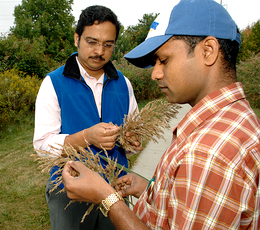Jun 3 2009
Researchers at the University of Delaware have discovered a new reason why the tall, tasseled reed Phragmites australis is one of the most invasive plants in the United States.
 University of Delaware plant scientist Harsh Bais (left) and Thimmaraju Rudrappa, former UD postdoctoral research who is now a researcher at DuPont, examine specimens of Phragmites australis. Kathy F. Atkinson/University of Delaware
University of Delaware plant scientist Harsh Bais (left) and Thimmaraju Rudrappa, former UD postdoctoral research who is now a researcher at DuPont, examine specimens of Phragmites australis. Kathy F. Atkinson/University of Delaware
The UD research team found that Phragmites delivers a one-two chemical knock-out punch to snuff out its victims, and the poison becomes even more toxic in the presence of the sun's ultraviolet rays.
The study, which is published in the June issue of the scientific journal Plant Signaling & Behavior, is believed to be the first to report the effects of UV-B radiation on plant allelopathy, the production of toxins by a plant to ward off encroachment by neighboring plants.
The authors include Thimmaraju Rudrappa, a former postdoctoral researcher at UD who is now a research scientist at the DuPont Company; Harsh Bais, assistant professor of plant and soil sciences; Yong Seok Choi, postdoctoral researcher in the Department of Chemical Engineering; Delphis Levia and David R. Legates, both associate professors in the Department of Geography; and Kelvin Lee, Gore Professor of Engineering and director of the Delaware Biotechnology Institute.
The research was conducted in Delaware wetlands and in Bais's lab at the Delaware Biotechnology Institute, a major center for life sciences research at the University of Delaware.
“The toxin secreted by Phragmites is degraded by sunlight -- ultraviolet rays -- and causes severe deleterious effects on other native plants,” Bais said.
“Our research also addresses the growing questions of increased UV-B incidences because of global warming and its ultimate effect on plants. In this case, an invasive plant is accidentally utilizing the changed global conditions for its survival and invasion,” Bais noted.
Two years ago, Bais led a study which discovered that Phragmites actively secretes gallic acid to kill off plants and take over new turf. Gallic acid, also known as 3,4,5-trihydroxybenzoic acid, is used for tanning leather, making dyes and inks, and formulating astringents, among other applications.
In this research, the scientists found that the gallic acid released by Phragmites is degraded by ultraviolet light to produce another toxin, mesoxalic acid, effectively hitting susceptible plants and seedlings with a double-whammy.
The mesoxalic acid triggers a similar “cellular death cascade” in victim plants as gallic acid does, Bais said, destroying the tubulin and actin, the structural protein in the roots, within minutes of exposure.
The scientific team detected the biological concentrations of mesoxalic acid in Delaware wetlands, in stands of both exotic and native Phragmites australis. The study highlights the persistence of the photo-degraded phytotoxin, particularly potent in the exotic species of the plant, and its enhanced effects against the native species of Phragmites, which is becoming increasingly endangered in the United States.
Walnut trees, pine trees, ferns and sunflowers are among the plants that release harmful chemicals to prevent other plants from growing too close to them.
However, Phragmites uses this strategy not so much to keep other plants away, but to aggressively conquer them and invade new territory, Bais said.
Funding for the project was provided by the University of Delaware Research Foundation.